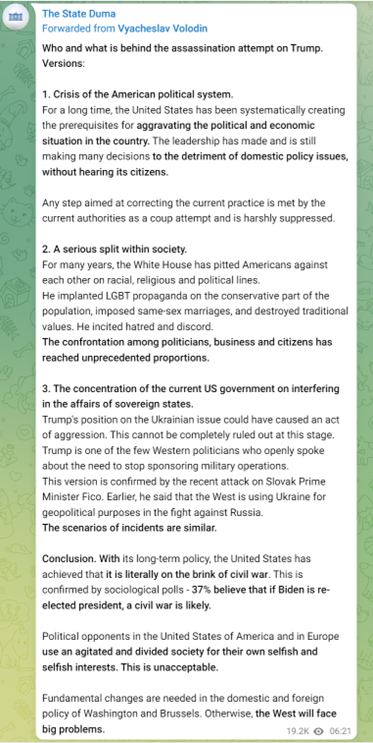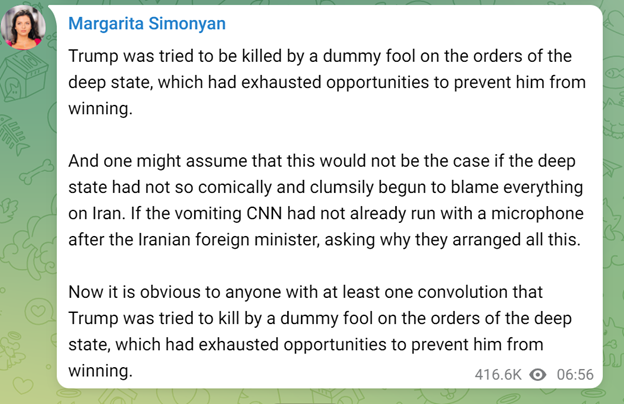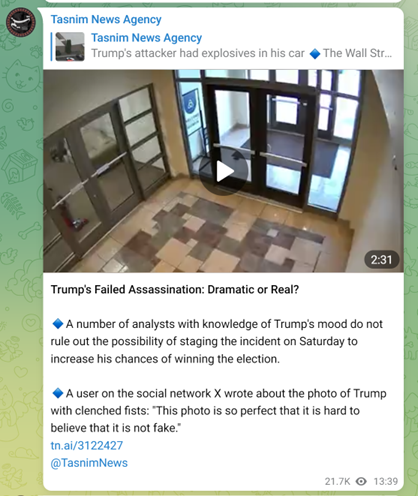American Democracy in the Crosshairs: Russian, Iranian, and Chinese State Messaging on the Attempted Trump Assassination
Introduction
In the days after the assassination attempt on former President Donald Trump at a rally in Butler, Pennsylvania, a torrent of false and misleading information about the attack flooded social media. While the majority of these claims seemingly originated from users in the United States and were amplified by actors across the political spectrum, certain authoritarian countries capitalized on the moment to amplify domestic partisan conspiracies and push narratives aimed at denigrating the United States and advancing their respective geopolitical agendas.
Using the Hamilton 2.0 dashboard, ASD analyzed the outputs of state-affiliated accounts from Russia, Iran, and the People’s Republic of China (PRC) across multiple social media platforms in the week following the attack. We found:
- Russian-state affiliated accounts suggested that the attempt on Trump’s life was motivated by opposition to Trump’s policies vis-à-vis Ukraine and that there might be a “Ukrainian trace” in the attempted assassination. This narrative was buttressed by Russian state media personalities who implied that the US “deep state” was complicit in, if not responsible for, the shooting. Russian propagandists also linked the assassination attempt to the perceived breakdown of democracy in the United States, blaming Democrats for creating an environment that fuels political violence.
- Iranian state media aimed to undermine the United States by leveraging US-grown conspiracies about the assassination attempt from both the left and right, claiming that either the deep state was involved or Trump “staged” the incident to boost his election chances. Following a CNN report alleging an Iranian plot to assassinate Trump, Tehran’s messaging shifted to denounce the accusations as “fake news”, “politically biased”, and “Zionist” fabrications.
- PRC-affiliated accounts provided limited coverage of the event in comparison to accounts affiliated with Russia and Iran. While their reporting was largely factual, they emphasized that the frequency and severity of political violence in the United States was a systemic issue.
Russia
Russian state-affiliated accounts have linked the attempted assassination of former President Trump to both the war in Ukraine and the United States’ internal political turmoil. As is customary, Russia’s propaganda strategy has not aimed for narrative consistency, instead layering different messages to targeted audiences in the United States, Russia, and other parts of the world. This multifaceted propaganda strategy seeks to, depending on the audience, exacerbate partisan divisions, undermine the credibility of the US political system, and erode support for US foreign policy goals—most notably in Ukraine.
Often, Russia amplifies and exploits existing sentiments in American public debate to contribute to chaos in the information domain. What is notable about Russia linking Ukraine to the attempt on President Trump’s life is that the narrative itself is very much a Russian creation. Russia’s intent, almost certainly, is that influential American actors will pick up the narrative that Ukraine was involved and, wittingly or unwittingly, use Kremlin talking points to justify a change in American support for Ukraine. Consequently, Russia hopes American voters would also change their views on Ukraine, having taken cues from American voices regurgitating a Russian-originated conspiracy.


Image translated by Microsoft
Russian state media outlets RT, Tass, and Sputnik claimed to have obtained a letter to Trump from Viktor Medvedchuk, a crony of Russian President Vladmir Putin and former Ukrainian politician who has lived in exile in Russia since 2022 and was sanctioned by the EU in 2024 for running a Russian influence operation in the Czech Republic. In the letter, Medvedchuk warned Trump that he has become “a personal enemy of the Ukrainian neo-Nazi [President Volodymyr] Zelensky” and that it was his belief “that there will be a Ukrainian trace in the assassination attempt”. Medvedchuk further claimed that the attack was motived by Trump’s promise to end the war in Ukraine, which would mean “the loss of power by the Nazi regime of Zelensky and his American curators from the Biden administration”. Those accusations were amplified by Russian state media outlets or key personnel in Japanese, Arabic, Farsi, Serbian, and Russian. In all cases, Medvedchuk was simply described as a Ukrainian “opposition leader”, with no mention of his ties to the Kremlin or his role in orchestrating pro-Russian influence campaigns.
Sergei Tsekov, a member of the Russian Senate from occupied Crimea, made similar claims in an interview with Izvestia, where he urged US authorities to consider the “involvement of the Ukrainian special services in the assassination attempt”. The State Duma echoed this sentiment in an official Telegram post that speculated that “Trump’s position on the Ukrainian issue could have caused an act of aggression."
Sputnik News also ran a story claiming that a Ukrainian military brigade “celebrated” the assassination attempt on Telegram. The headline, however, is clearly misleading, as the article itself makes quite clear that the post was a satirical response to allegations of Ukrainian involvement.


The “deep state” and domestic divisions
A complimentary narrative to the “Ukraine trace” theory was the idea that US intelligence and law enforcement—the so-called “deep state”—was involved in the shooting. This theory was pushed almost immediately after the incident by Margarita Simonyan, the editor-in-chief of RT, who likened the assassination attempt to the killing of President John F. Kennedy. Clearly evoking historical conspiracy theories about the Kennedy assassination that have festered since the 1960s—and popularized by pro-Putin filmmaker Oliver Stone—Simonyan’s post implied that the shooting was a state-sponsored effort to remove an “inconvenient president”.
Simonyan was later more explicit, asserting in a Telegram post that the assassination attempt was orchestrated by a “dummy fool on the orders of the deep state, which had exhausted opportunities to prevent [Trump] from winning”. That post was shared by Vladimir Solovyov, host of one of Russia’s most watched talked shows. Solovyov also connected the shooting to the Kennedy assassination, commenting in a separate post that the “killer died successfully (as in the case of President Kennedy), and the conspirators themselves, in the meantime, would have been sawing off the military budgets of the United States, NATO and allies for another four years, fanning wars around the world”.
Efforts to link the shooting to the Kennedy assassination were also evident in dozens of state media and embassy posts that cited comments made by Bobby Kennedy III, the son of presidential candidate Robert F. Kennedy Jr. Kennedy, whose grandfather and great uncle were both assassinated, blasted the secret service in a post on X (formerly Twitter). That post became fodder for an RT article and was referenced by Ministry of Foreign Affairs spokesperson Maria Zakharova, who suggested in a Telegram post that funding for Ukraine would have been better spent on “American police and other services that are supposed to ensure law and order within the United States”.
Sputnik Serbia also referred to the shooting as “Operation Oswald”, a reference to Kennedy assassin Lee Harvey Oswald. Kremlin-linked accounts also played on classic tropes, blaming liberal media and elites for the violence. Kremlin spokesperson Dmitry Peskov accused the Biden administration of creating an “atmosphere of violence”, though he did elaborate that the Kremlin does not believe the shooting “was organized by the present power”. The aforementioned State Duma Telegram post blamed the White House for pitting Americans against each other and for forcing “LGBT propaganda” on conservatives. Sputnik News attributed the assassination attempt to Democrats’ “anti-Trump rhetoric”, a theme Zakharova also stressed when she portrayed the attempt on Trump’s life as proof that the United States “has been brought to a suicidal state by liberalism”. This rhetoric peaked with an article from the Strategic Culture Foundation, a US-sanctioned outlet linked to Russian intelligence, which suggested the United States is a “failed state” that is “close to absolute social collapse”. That article also hinted at CIA and FBI involvement in the assassination attempt.
Iran
In its initial response to the shooting, Iranian state media emphasized the United States’ “history of political violence” and suggested that the assassination attempt could have been avoided if the country had “actual gun control”. The Persian language arm of Fars News suggested that the shooting marked the “beginning of political violence and instability in the United States”. Iranian propagandists further criticized the US media for its supposedly disproportionate coverage of the incident over other geopolitical crises, claiming that “Trump’s ear injury is more newsworthy than the killing of 90 Palestinians in Gaza.”
Iranian state-backed media outlets also have amplified hyper-partisan speculation and conspiracies circulating in the US social media ecosystem. Unlike Russian state media, which almost exclusively sampled from right-leaning conspiratorial narratives, Iranian state-backed actors attempted to legitimize false claims circulating among both the political left and right. On Telegram, Tasnim, Irib, and Fars questioned whether the failed assassination was “real or fake”, claiming analysts have not ruled out the possibility of Trump “staging” the incident to boost his electoral prospects. Mehr News Agency also suggested that the shooting was “for the sake of [Trump’s] popularity” and that if the shooting were subsequently proven to be a “fabricated show” it would lead to another Watergate scandal. These posts, however, were all in Farsi, suggesting that the primary audience for the content was not a domestic US one.
Other Iranian state outlets highlighted conspiratorial narratives from the political right in the United States, particularly those that suggested deep state involvement in the attack. At least five Telegram posts from PressTV cited or linked to videos from conservative political commentator Dan Bongino, who claimed to have “damning evidence” about the attack and questioned the credibility of the FBI’s investigation into the incident. PressTV also promoted a post from an anonymous X account that accused some members of the Secret Service of “hiding” during the incident. Other state media channels and accounts amplified Representative Marjorie Taylor Greene and other American right-wing voices who implied that Biden was culpable for the attack.
On July 16, Tehran’s messaging pivoted in response to a Iranian plot to assassinate Trump in retaliation for the death of General Qasem Soleimani, whose assassination was ordered by Trump in 2020. Iranian state media vehemently denied Tehran’s role in the Trump assassination attempt. Some outlets even framed the accusation as an anti-Israel conspiracy, reposting a video by right-wing provocateur Jackson Hinckle with the title “ZIONISTS win again”. PressTV also linked to comments from conservative commentator Candace Owens, who suggested that the CNN story was “disinformation” planted by the CIA and that the United States would be safer if it would “just stop bombing the Middle East”.
The People’s Republic of China
In contrast to the aggressive and conspiratorial narratives pushed by Russia and, to a lesser extent, Iran, the PRC’s coverage of the attempted assassination was minimal and for the most part factual. Notably, between July 13 and July 22, monitored Russian state media outlets devoted eleven times more coverage and Iranian outlets four times more coverage of the assassination attempt than their Chinese counterparts.1
PRC state media accounts did, however, underscore the United States’ history of “political violence”, Additionally, a few state-linked commentators on X derided the US media’s handling of the incident, implied that the shooting was a deserved consequence of America’s internal issues, and speculated that the Republicans would gain an advantage in the November election. A few PRC state-backed media outlets also claimed that the shooting is evidence that “America[n] society is filled with horror, anger, and division” and that “large countries have crumbled because of internal rather than external factors”, suggesting that this is the fate befalling the United States.
Conclusion
The narratives that Russian, Iranian, and PRC state media and political figures have promoted in the aftermath of the assassination attempt on Trump reveal that Moscow, Tehran, and Beijing have, despite their shared interest in framing the incident as indicative of US political decline, different messaging approaches, audiences, and opinions on the prospect of another Trump presidency. Russian messengers, for example, largely amplified narratives that were broadly aligned with conspiratorial narratives that emerged on the political right in the United States. Even its effort to link the attack to Ukraine, a narrative that was not prominent in the domestic US ecosystem, was an appeal to the isolationists and those looking for further ammunition to drawdown US support for Ukraine, who exist largely but not exclusively on the right. Iranian-linked actors, on the other hand, played to a more global audience that is broadly skeptical of or hostile to US foreign policy. In fitting with this theme, Iranian state media promoted the idea that US intelligence was involved in the shooting, but they also elevated left-wing conspiracies that suggested that the attack could have been staged to boost Trump’s electoral chances. Iran also linked the shooting to its own geopolitical interests, namely US involvement in the Middle East. PRC state media was by far the most reserved of the three monitored networks, providing far less coverage, and less editorialized coverage, than their Russian and Iranian counterparts. This is largely in keeping with the PRC’s approach to US political controversies, which it largely avoids, even as it has shown an increased inclination in recent years to more aggressively message about social issues in the United States.
Although all three countries broadly benefit from a weakened United States and have shown a willingness to exploit American divisions in the past, this is a case where each country’s strategic interests, posture toward Trump, and appetite for reputational risk has created noticeable differences in their approaches to messaging about the assassination attempt.
1 Amount of coverage determined by searches for “assassination” between July 13-17. This query likely included some posts that were unrelated to the Trump assassination. In addition, ASD’s Hamilton dashboard tracks different numbers of state media accounts affiliated with the three monitored countries, meaning that the total volume of content collected from each country is not equal.




